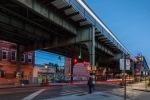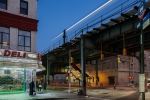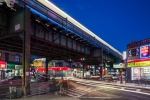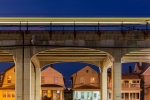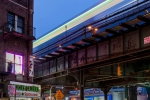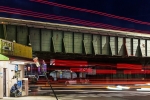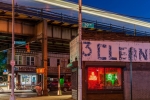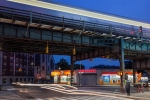It is part of life in New York City to wait for the subway. It is an experience that New Yorkers have in common, especially now as deferred maintenance and underfunding have led to a deterioration in service. I have been spending entire evenings waiting for the elevated trains as they pass through Brooklyn, Queens and the Bronx. Below the tracks, it is dark in the day, deafeningly loud when the trains pass by. And yet, these corridors along Broadway, Myrtle Avenue, McDonald Avenue, and Jamaica Avenue among others also offer lower rent and community. While there are some chains, primarily mom-and-pop stores—such as the Lion’s Den, a used furniture shop, Mr. Kiwi’s Fruits and Vegetables, and Sam the Glazier—often started by immigrants, operate here. This is the heart of New York City. The trains, thundering overhead, are a metaphor for both the opportunity and the hardships of living here.
Waiting for a train just after sunset, as the light turns blue and the tone of the sky darkens to match the tones of the ground, I work like a painter. I am not quite in control of the image, dependent on the flow of traffic and the subway schedule. When the train does pass by, it creates a brushstroke of light. Cars and buses also move through the frame drawing red and white lines. Pedestrians are blurred by the long exposure. The lights turn on along the street and in homes and businesses, just before it becomes night, and add color. The result is magic, beauty created by the camera from the movement of the city and the mix of artificial and natural light at the end of the day. And for few brief minutes before it gets dark, the ordinary streets, the ones usually passed through to get to work, to get back home, to go to the store, appear vibrant and alive. Photographic color brings attention to what has been hidden as ordinary and mundane.





